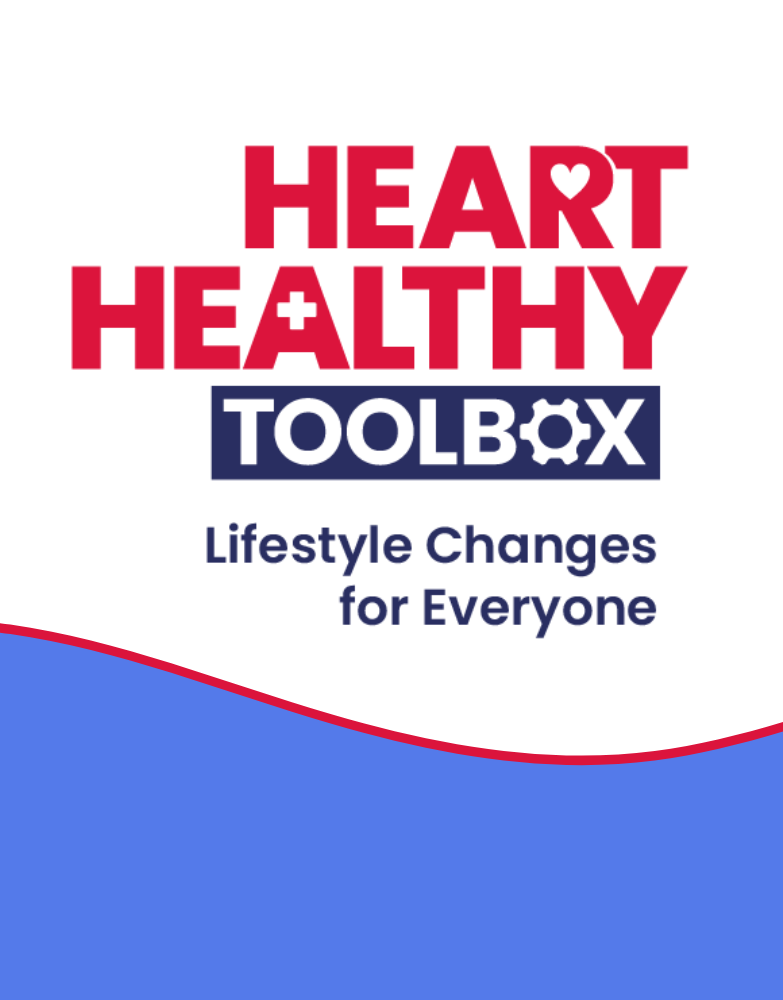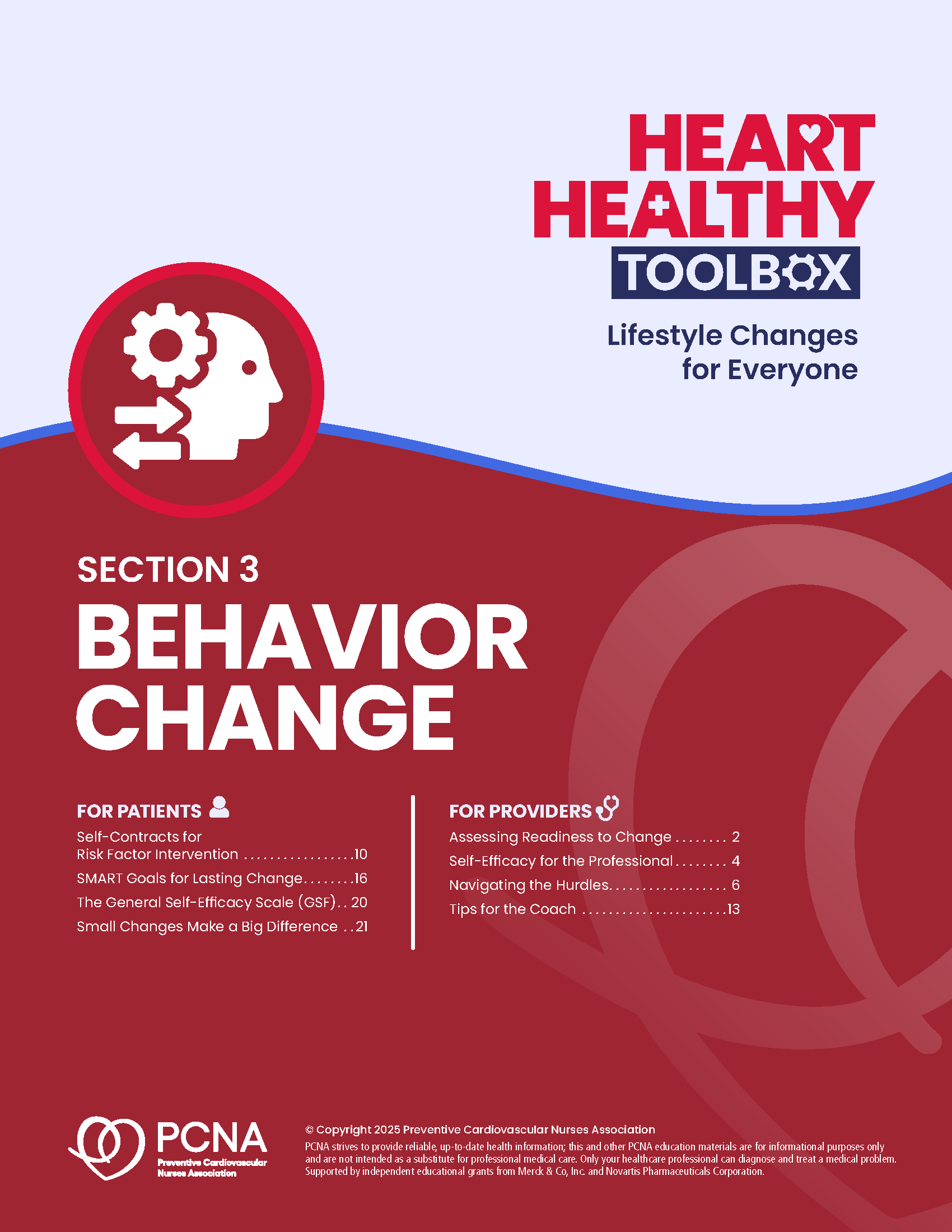An overview of behavior change theory and how to apply it into clinical practice is complemented by patient-facing tools on developing SMART goals and developing strategies for reaching goals and overcoming barriers along the way.
Components
Components are available to download individually or together as the whole section. You can also view all sections of the Heart Healthy Toolbox.
For Patients
- Self-Contracts for Risk Factor Intervention
- SMART Goals for Lasting Change
- The General Self-Efficacy Scale (GSF)
- Small Changes Make a Big Difference
For Providers
- Assessing Readiness to Change (also available below)
- Self-Efficacy for the Professional (also available below)
- Navigating the Hurdles (also available below)
- Tips for the Coach (also available below)
Assessing Readiness to Change
Transtheoretical Model
The Transtheoretical Model describes the stages of behavior prior to change. It focuses on the individual’s decision-making and has been used in a variety of problem behaviors. This model involves the state of feeling, awareness, judgments, perceptions, and behavior.
The Transtheoretical Model describes the process of change in 5 stages.
- Precontemplation: The person has no intention to change or take action within the near future. In this stage, people are usually uninformed about the consequences of their behavior or they may have failed at previous attempts to change. They may avoid seeking information that would help them change their behavior.
- Contemplation: The person intends to change within the next 6 months. They are aware of both the positive effects and the negative effects of change. This can cause uncertainty as to which approach to follow and result in procrastination and the inability to make a move to change. This person is not ready for an action program.
- Prepartion: The person plans to take action within the next month. They are usually prepared and have a plan of action. A program of action that assists with behavior change would be beneficial, such as a smoking cessation, weight loss, or an exercise program.
- Action: The person has made significant modifications in their behavior and way of life.
- Maintenance: The person is not working as hard as the person in the Action mode, but is working to prevent a relapse. The person is confident about continuing to change.
Self-Efficacy for the Professional
Understanding the Theory/Concept
Perceived self-efficacy is defined as a person’s builds on a person’s belief in their ability to produce specific levels of performance that have influence over events that affect their lives. “Self-efficacy beliefs determine how people feel, think, motivate themselves and behave. Such beliefs produce these diverse effects through four major processes. They include cognitive, motivational, affective, and selection processes.”
A person with a strong belief in their own ability to approach difficult problems faces the challenge rather than avoids it. The individual sets high goals and is committed to achieve the goal. If a person fails, they sear for a way to improve their knowledge and skills to tackle the problem again. “They quickly recover their sense of efficacy after setbacks or failure.” This strong sense of efficacy results in accomplishment and less risk of depression.
In contrast, a person with a low belief in their ability to confront problems shies away from difficult tasks, viewing them as a personal threat. When confronted with a difficult task the person focuses on their weaknesses and possible obstacles, rather than a solution to the problem. This person has low aspirations and weak commitments to the goals their wishes to achieve. Previous failures contribute to one’s lack of faith in their capabilities. These individuals are at higher risk of depression.
Working with Your Patients
In discussing risk factor behavior changes and making a plan, ask patients how confident they are to make the agreed upon change (on a scale of 1-100% or 1-10). The individual is more likely to be successful when their confidence level is 70% or greater.
- Explain the problem; ask the patient for possible solutions.
- For those who have anxiety, set goals in small stages.
- Assess their self-efficacy and focus on moving it toward a 70% confidence level. (See General Self-Efficacy Scale (GSE))
- Introduce the patient to someone who has faced a similar health problem, eg, refer the patient to a cardiac rehabilitation program where they may learn some coping strategies.
Sources of Self-Efficacy
- Mastery of experiences—Each successful experience builds on a person’s belief in their ability to overcome difficulties. This cannot only be done through easy success, it also requires experience in overcoming obstacles through continuing effort.
- Vicarious experiences through social models—Observing others achieve success helps individuals believe that they can achieve similar success. On the contrary, observing the failure of another person to achieve a similar goal can cause doubts that the person can overcome a similar problem. The impact of modeling on perceived self-efficacy is strongly influenced by the perception that there is a similarity of you or your situation to the models.
- Social persuasion—Encouraging words from others can help motivate a person to overcome fears and doubts. These boosts in perceived self-efficacy lead people to try harder to succeed and promote development of skills and a sense of personal efficacy.
- Reduce one’s stress reactions—Encouraging a positive attitude reduces stress and decreases negative thoughts.
Self Efficacy beliefs contribute to motivation by determining the goals people set for themselves, how much effort they will put forth, how long they will persevere, especially when it is difficult, and their resilience to failures.
Glossary
- Affective Processes—Processes regulating emotional states and elicitation of emotional reactions
- Cognitive Processes—Thinking processes involved in the acquisition, organization, and use of information
- Motivation—Activation to action. Level of motivation is reflected in choice of courses of action and in the intensity and persistence of effort.
- Perceived Self-Efficacy—People’s beliefs about their capabilities to produce effects
- Self-Regulation—Exercise of influence over one’s own motivation, thought processes, emotional states, and patterns of behavior
Adapted from:
Bandura A. Self-efficacy. In VS Ramachaudran, ed. Encyclopedia of human behavior. 4th ed. New York: Academic Press; 1994:71-81. Reprinted in H Friedman, ed. Encyclopedia of mental health. San Diego: Academic Press; 1998.
Navigating the Hurdles
Helping Your Patients Overcome Barriers to a Healthier Lifestyle
Helping patients make a lifestyle change is a challenge for health care professionals with limited time allocated during typical outpatient clinic visits. Cognitive-based behavior change strategies seem to be key to successful change. These strategies focus on changing how an individual thinks about themselves, their behaviors and life circumstances.
The Healthy Life Check-Up tool helps patients become aware of current habits they would like to change and areas where they need information or direction. Consider using the following strategies as you counsel patients regarding lifestyle change. They have demonstrated merit
for successful lifestyle change, especially when two or more of these strategies are employed simultaneously.
Goal Setting
Helping your patients set goals that are specific, short-term and realistic is a key first step in any lifestyle change effort. Regular, easily measured feedback, such as daily steps on a pedometer, help patients stay on track and measure progress towards a goal. Patients should be encouraged to break big goals down into smaller goals; for example, “walk a block before you walk a mile.” Small successes help to build confidence and increase motivation to stick with a lifestyle change. Some insurance will cover Silver Sneakers and other fitness activities, which provide social as well as physical health benefits.
Use the “Smart Goals” tool to help your patients with realistic goal setting.
Self Monitoring
Encourage patients to track their progress using a journal or log of eating habits and/or daily activity. Electronic applications and pedometers are useful devices for creating awareness about behavior and any barriers to change. More frequent and immediate monitoring is most effective for changing behavior. Writing down what you’ve eaten during or right after a meal/snack for example, is better than attempting to recall daily food intake at the end of the day. Ask patients to periodically report progress by sending in copies of their logs and/or bringing them to the clinic for discussion during follow up visits.
“Jotting it Down” is an example of a self-monitoring tool.
Frequent and Prolonged Contact
Before your patient walks out the door, schedule a follow-up session. Make sure the follow up is within a few weeks during the early stages of a behavior change. Frequent contact helps to build trust and communicates a sense of care and importance as it relates to the behavior change. Progress towards goals should be discussed and modifications to the behavior change program should be established. These follow-up sessions can be face to face, over the phone, via text or video. Consider referring the patient to a group intervention where weekly sessions can help provide regular support, feedback and commitment to change.
Feedback and Reinforcement
Patients can measure progress if they receive regular feedback regarding on a regular basis regarding a specific behavior change. This feedback can be used as a reinforcement to continue to practice a new behavior and/or a motivator to do more to get desired results. In addition to direct, in-person feedback, recent innovations include the use of texting, digital applications, or mobile devices that include software for self-monitoring progress toward a goal.
Self-Efficacy
An individual’s perception of their ability to learn a new task or practice a new behavior is defined as self–efficacy. The higher a patient’s self-efficacy is, the more likely they are to initiate a new behavior and continue their efforts until success is achieved. There are 4 sources of building
self efficacy, which can be built into a lifestyle change program:
- Mastery experiences: success in achieving a goal that is proximal and reasonable (small and realistic)
- Vicarious experiences: observing someone else learn a new task, make a successful change, or achieve a goal
- Verbal persuasion: the provider expressing a belief in the patient’s ability to learn a new skill or practice a new behavior
- Physiologic feedback: being aware of feeling better or having fewer symptoms, such as dyspnea with exertion, as a result of a lifestyle change
Modeling
Having your patient observe someone performing the desired behavior can serve as a powerful behavior change tool. Exercise programs with a credible leader, or cooking classes that demonstrate healthy food preparation, are good examples of modeling. A video can be substituted if in-person opportunities are not available. Having your patient meet with someone who has been successful in making a behavior change is another form of modeling and commonly occurs in support groups, such as Alcoholics Anonymous (AA).
Problem Solving
There are 5 common steps to problem solving:
- Identifying and defining the problem
- Brainstorming solutions
- Evaluating the pros and cons of potential solutions
- Implementing the solution plan
- Evaluating its outcome/success
These steps can be used to help patients overcome barriers to behavior change. Use open-ended questions and reflective listening as much as possible to allow patients to identify the problem and potential solutions.
Use the patient tool “Tricks of the Trade” to help patients problem solve common setbacks when trying to become more active.
Use the patient tools “A Healthy Diet without Breaking the Bank” and “Dressing on the Side, Please” to help patients navigate the grocery store and restaurant menus.
Relapse Prevention
Make patients aware that it is normal to deviate from prescribed plan for change. Have patients reflect on past experiences, barriers to change, and problem solve solutions in advance. Let them know that getting off track is not a failure. If they miss a few exercise classes, it’s OK—no need to give up on their whole program.
Motivational Interviewing
This directive, patient-centered counseling style helps individuals explore and resolve their own ambivalence. Seven key principles are central to motivation interviewing.
They are:
- Motivation to change needs to come from within the individual not imposed on them
- It is the patient’s job to state and resolve their own ambivalence
- Direct persuasion is not effective for resolving ambivalence
- The counseling style is quiet and eliciting
- The counselor is directive in helping the patient examine and resolve ambivalence
- The stage of readiness to change is in constant flux and not a fixed trait
- The therapeutic relationship is a partnership, and not one based on the expert and the passive recipient
Review the “Tips for the Coach” before you go in to a patient encounter. The brief scripts here can help you feel confident as you navigate a discussion around a behavior change.
Tips for the Coach
Brief Guide to Motivational Interviewing
Use this tool as a quick review of motivational interviewing strategies as you begin a behavior change counseling session. The focus is patient-centered, where motivation to change comes from within the patient and not imposed on them. The examples below are based on helping a patient start an exercise program, but can be translated to changing eating habits, smoking cessation, or other lifestyle changes.
Express Empathy
Goals:
- Communicate respect for the patient.
- Avoid communication that implies superior/inferior relationship.
- Respect patient’s freedom of choice and self-direction.
- Seek ways to compliment rather than denigrate. Build up rather than tear down.
- Focus on listening rather than telling.
Strategies:
- Use open-ended questions to explore:
- The importance to making a lifestyle change.
- “How important do you think it is for you to start exercising?“
- The importance to making a lifestyle change.
- Concerns and benefits of starting an exercise program.
- “What might happen if you…?”
- Use reflective listening to summarize and seek shared understanding:
- Reflect words, meaning, and summarize:
- “So you think you can’t afford to buy exercise gear.”
- “What I have heard you say so far is that you don’t have time to exercise, on the other hand you feel guilty about the time you spend playing computer games and you are concerned about the weight you’ve gained.”
- Reflect words, meaning, and summarize:
- Normalize feelings and concerns:
- “Many people worry about keeping up with others in an exercise class.”
- Support the patient’s autonomy and right to choose or reflect change.
- “I hear you say you are not ready to start exercising now. I am here to help you when you are ready.”
Roll with Resistance
Goals:
- Create opportunities for new ways of thinking about problems, without imposing them.
- Reinforce the concept of ambivalence as normal and necessary to explore.
- Help evoke solutions from the patient.
Strategies:
- Back off and use reflection when the patient expresses resistance.
- “It sounds like you’re feeling bad about not being able to keep up with your kids.”
- Express empathy.
- “You are worried about getting out of breath when you exercise.”
- Ask permission to share information.
- “Would you like some information about how to safely start an exercise program?”
Develop Discrepancy
Goals:
- Help patients become aware of the gap between where they are and where they want to be.
- Enhance and focus the patient’s attention on these gaps.
- Raise patient’s awareness of personal consequences of the current behavior.
- Elicit patient’s concern that would favor change.
- Support SMART goal setting.
Strategies:
- Identify the discrepancy between the patient’s present behavior and expressed priorities, values and goals.
- “It sounds like playing sports with your kids is important to you. How do you think exercise will affect this time with them?”
- Reinforce and support “change talk” and commitment language.
- “So, you realize that you would feel better if you could find the time to exercise. It is great that you are going to start walking over your lunch hour as soon as you get your big project done at work.”
- Build and deepen commitment to change.
- “It is great that you are looking at exercise and healthy eating as a way to manage your weight and bring your blood pressure down.”
- “What parts of your diet and physical activity are you interested in improving?”
Support Self Efficacy
Goals:
- Promote the patient’s belief that they can perform a particular behavior or accomplish a specific task.
- Help to instill hope or optimism.
Strategies:
- Help the patient identify and build on past successes.
- “So you were able to complete the 2 mile heart walk?”
- Offer options for small steps toward successful lifestyle change.
- Start walking 5-10 minutes over the lunch hour.
- Take the stairs instead of the elevator.
- Keep a bag with your “gym clothes” in the car.
Supported by independent educational grants from Merck & Co, Inc. and Novartis Pharmaceuticals Corporation.
Resource Details
Reviewed on
September 3, 2025
Language(s)
- English
Download Resource
Related Resources







